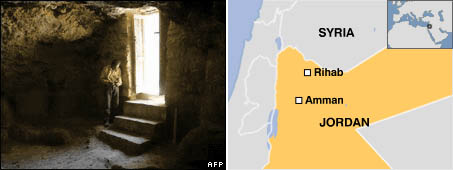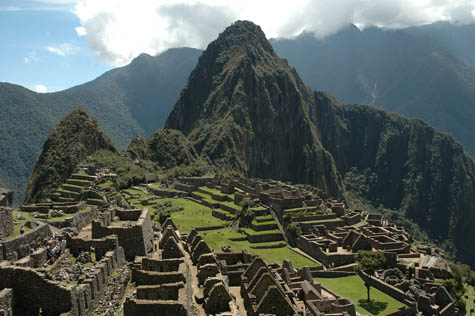Lost and Found
 [Image: The world's oldest Christian church? A cave in Jordan, via the BBC].
[Image: The world's oldest Christian church? A cave in Jordan, via the BBC].Some archaeology for a Tuesday evening:
1) Is a cave in Jordan the world's oldest Christian church? "The cave is beneath the ancient church of St Georgeous, itself one of the oldest known places of worship in the world," the BBC reports. "According to Dr. Abdul Qader Al-Hassan, the director of the Rihab Centre for Archaeological Studies, the cave site shows clear evidence of early Christian rituals that predate the church." This subterranean place of worship has been tentatively dated at 70 A.D.
 [Image: The re-discovery of Egypt's missing pyramid, photographed by Amr Dalsh of Reuters and Nasser Nasser of the Associated Press].
[Image: The re-discovery of Egypt's missing pyramid, photographed by Amr Dalsh of Reuters and Nasser Nasser of the Associated Press].2) This is the same week, of course, that a "lost" pyramid was re-discovered in Egypt – re-discovered, because it had previously been lost.. and discovered... only to be lost... and re-discovered.
According to CNN, "the pyramid, of which only the base remains, is believed to be that of King Menkauhor, an obscure pharaoh who ruled for only eight years more than 4,000 years ago." It seems to have been first dug up in the 1840s by a German archaeologist – only to disappear again beneath the desert sands.
 [Image: Macchu Picchu photographed by Flickr-user Eric in SF].
[Image: Macchu Picchu photographed by Flickr-user Eric in SF].3) Another German archaeologist was recently in the news, however: Augusto R. Berns, who "discovered" Macchu Picchu back in 1867, a good four decades earlier than anyone thought, only to "ransack" the place.
From the Telegraph:
- In a letter [Berns] boasts of finding "significant rustic buildings and underground structures that have been closed with stones," believed to be the first written description of Machu Picchu.
These, he speculates, would "undoubtedly contain objects of great value and prove part of the treasure of the Incas."
In the same document, he claims that he has the backing of the "Supreme government" to access and sell the treasures.
4) And while this last bit is neither news nor to be believed, I find it interesting nonetheless. Is there a "subterranean city located beneath the former Inca capital of Cuzco"?
- In 1952, a mixed group of twelve French and American explorers managed to gain access [to this underground city] with enough provisions to last for five days as they embarked upon what they termed “the greatest discovery since Machu Picchu.”
The team ventured into the [tunnels] and nothing further was heard from them until fifteen days later, when French explorer Phillipe Lamontierre emerged from the hole suffering from acute dementia, with visible signs of malnourishment and even the bubonic plague... The broken survivor indicated that his fellow adventurers had died, and some of them had even fallen down unfathomed abysses. Among the objects he brought back was an ear of corn made of solid gold, which was later entrusted to the Cuzco Museum of Archaeology.
You're on a road crew, blasting through the mountains outside Quito, deep in the compression and strain of old bedrock, with incomprehensible stratigraphies arching with strike and dip all around you... when you scrape away some rock and find a serial number.
The mountains were manufactured.
There's even a number you can call for customer complaints.





Comments are moderated.
If it's not spam, it will appear here shortly!
There's even a number you can call for customer complaints.
One has to wonder what the area code would be.
They were probably designed by the firm that employed Howard Baker, the architect hero of Michael Frayn's novel Sweet Dreams. After driving through a red light he discovers himself on the road to a very middle class heaven where his new job is designing fjords.
Re: number 5 - would that be a direct line to Douglas Adams in the after world?
Have you read Gene Wolfe's Book of the New Sun? Mountains transformed into statues, beaches of glass ground to sand over millennia, people mining the remains of civilisations, compressed into pseudo-geological strata...
I've never read that Gene Wolfe book, actually, but I'll check it out. It's good?
And, Ian, I didn't realize that was the plot of Frayn's book; I love the idea!
If you knew who Slartibartfast is you'd know where the Fjords came from. :)
Just as long as the serial number isn't "4 8 15 16 23 43". Sorry, had to say it.
The tale of a cavern beneath Cuzco reminds me of a family legend. My husband's great uncle spent many years travelling the desert between Four Corners and Mexico, especially the area called the Superstition Mountains and points south. He swears he met a race of people who lived in canyons so deep, they never saw the sun, and subsequently that their skin was white as snow. We always took him for a spinner of tall tales, but we discovered there are more than a few pieces of Conquistador armor in local museums with his name as the donor. He just found them in the desert he claimed.
I love stories like that.
Re: Book of the New Sun: Well, it won every major fantasy and sf award back in the eighties, and I - and a number of other people - really like it, though 'like' is perhaps a misleading word; it's a difficult book to like, with a rather unpleasant 'hero'. But even if you should end up really despising the protagonist (I didn't, but some people do), it's worth it for the 'sights' alone, IMO. Especially for someone with an interest in mindboggling geographical extrapolations. I'm attracted to it for many of the same reasons I'm attracted to your blog.
On your last conjecture: Terry Pratchett wrote one of his earlier novels Strata around this very premise: and even introduced a sort of proto-discworld from his later novels in it.
Needs a drawing or two I think of these lost/fictive cities. Very provocative.
I've heard of these sunless people- there's a similar legend about Mt. Shasta in Northern California, in fact, but that one's almost certainly early-1900's art-nouveau-literature inspired.
then there are the rooms and channels within the Grand Canyon that the Hopi either discovered or created.
back to Peru, what do you make of this:
http://wideruins.blogspot.com/2008/06/armchair-archaeology.html
might goofy, but I can't say it isn't intrguing!
Post a Comment